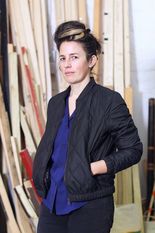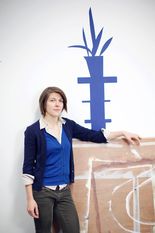Behind the masks of erotic artist Cecilia Lundqvist
‘I was thinking the other day that I’m doing pretty much what I loved to do when I was six years old,’ says Cecilia Lundqvist, sitting on her bedroom floor. ‘When I’m working from home, listening to Swedish radio and playing with glue and feathers – that’s when I feel the most happy.’
There’s something very whimsical about Lundqvist, an artist who specialises in hand-made animal masks and also dips into performance art. Her themes have been with her since childhood, but her work is often put in the realm of ‘adults only’ – sold in upmarket sex shops and lingerie boutiques.
‘It’s funny, because I didn’t originally create the masks to be erotic,’ she says. ‘They came about when I was doing a bit of physical theatre – as a vehicle for driving storytelling, just like you use a costume. But anything that hides your personal identity can be seen as erotic as well. It’s a liberating thing – you feel transformed and free, whether that’s to act ridiculous, or take on a scary persona, or be sexual.’
Storytelling is at the centre of Lundqvist’s work. ‘The masks I create are like cartoon characters infused with personas. The feline character is like a femme fatale – someone who doesn’t really give a damn about the world around her. She’s someone who seduces. The bunny is much more innocent – she’s someone to be seduced.’
The masks are usually made with fur, which comes from secondhand stoles, hats or coats that Lundqvist finds at markets. She’s tried fake fur too, but prefers the real thing – partly for its texture and smell, and partly for the history it brings to her work.
She is Swedish, but has lived in London for 12 years. ‘I don’t have formal art training. I came to London to study film and French. I was also doing a lot of art modelling at the time, and I think the film studies informed my thinking – I got very into that glamorous idea of how characters behaved in French films and I sometimes took that persona to the modelling. I started to think about how the model can direct what people are drawing. If you pose with a certain attitude, sometimes people pick up on that and they might add a cigarette to your hand, for example.’
The idea inspired Lundqvist to turn her modelling into performance. With her friend Marilyn Rose, she created Kink Ink, a life-drawing event with a theatrical feel. They would take over a venue and create an intriguing scene for guests to sketch – and they would use masks as props. On one occasion Sam Roddick, founder of erotic boutique Coco de Mer, invited them to pose in her window. She saw the masks in their rough state and asked Lundqvist to create some to sell in the shop.
Since that turning point, the masks have taken on a life of their own. They’ve been shot for GQ, worn by Rihanna’s dancers on X Factor, modelled by Rosie Huntington-Whiteley for Complex magazine and snapped on Daisy Lowe, who requested one for a party. They’ve been part of installations at Fortnum and Mason and a window display at Start London. They even recently popped up on Made In Chelsea, in the background of a scene shot at Coco de Mer.
‘That made me laugh,’ says Lundqvist. ‘Made In Chelsea isn’t necessarily my chosen way of displaying them, but I’m not precious about how my work is seen – I can’t really muster up that kind of protectiveness. They’re masks of animal characters, so basically they’re quite funny.’
They may have a humour to them, but they’re made with remarkable care and attention to detail – Lundqvist even decorates the inside of the mask with scraps of found fabric or animal details. It’s painstaking work. ‘What I’m doing is a labour of love and madness,’ she says. ‘Sometimes it’s quite punishing, and I wonder how I started doing these things that take 10 hours to make. So I sit there and curse, and I go into concentration mode. Most of the time, it’s meditative and lovely – and I’m doing exactly what I’ve always wanted.’

















